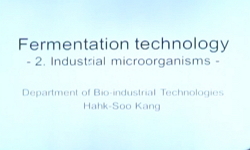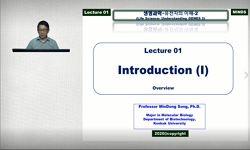목질계 바이오매스의 초임계수 처리 후 얻어진 당화액 내에는 유기산 및 Furfural, 5-hydroxymethylfurfural과 같은 다양한 부산물들이 존재한다. 이러한 부산물은 효모의 성장 및 에탄올 발효를 저해...
http://chineseinput.net/에서 pinyin(병음)방식으로 중국어를 변환할 수 있습니다.
변환된 중국어를 복사하여 사용하시면 됩니다.
- 中文 을 입력하시려면 zhongwen을 입력하시고 space를누르시면됩니다.
- 北京 을 입력하시려면 beijing을 입력하시고 space를 누르시면 됩니다.
https://www.riss.kr/link?id=A106361832
- 저자
- 발행기관
- 학술지명
- 권호사항
-
발행연도
2019
-
작성언어
Korean
-
주제어
yeast ; bioethanol ; fermentation ; inhibitors ; tolerance
-
자료형태
학술저널
-
수록면
16-22(7쪽)
- 제공처
-
0
상세조회 -
0
다운로드
부가정보
국문 초록 (Abstract)
이전 연구에 의하면 목탄을 이용하여 저해물질을 약 95% 이상 제거한 바 있으나, 어렵게 얻어진 당의 손실과 여전히 당화액에는 부산물이 존재하여 미생물을 이용한 에탄올 발효 과정에서 발효균주의 생장과 발효효율 저해 요인으로 작용하고 있다. 따라서 본 연구에서는 당화액에 포함되어있는 저해물질 중 아세트산을 대상으로 당화액 내 농도변화에 따른 효모의 생장 및 발효 효율에 미치는 영향을 조사하였다. 구체적으로는 상업용 에탄올 생산 균주인 I. orientalis와 S. cerevisiae를 이용하여 아세트산이 0, 1, 2, 4, 8%가 포함된 조건에서 성장 및 발효능을 조시하였고, 그 결과 I. orientalis의 경우 4%, S. cerevisiae의 경우 2%가 균주 생장을 위한 최대 한계농도임을 확인하였으며, 발효효율에도 직접적인 영향을 미치는 것을 확인하였다.
목질계 바이오매스의 초임계수 처리 후 얻어진 당화액 내에는 유기산 및 Furfural, 5-hydroxymethylfurfural과 같은 다양한 부산물들이 존재한다. 이러한 부산물은 효모의 성장 및 에탄올 발효를 저해시키므로 효율적인 에탄올 발효를 위해서는 당화액 내 저해물질을 제거하는 것이 중요하다. 당화액의 정제공정은 공정에서 생산단가 상승으로 이어지기 때문에 당화액 내 발효저해물질의 농도를 결정하는 것이 필요하다.
이전 연구에 의하면 목탄을 이용하여 저해물질을 약 95% 이상 제거한 바 있으나, 어렵게 얻어진 당의 손실과 여전히 당화액에는 부산물이 존재하여 미생물을 이용한 에탄올 발효 과정에서 발효균주의 생장과 발효효율 저해 요인으로 작용하고 있다. 따라서 본 연구에서는 당화액에 포함되어있는 저해물질 중 아세트산을 대상으로 당화액 내 농도변화에 따른 효모의 생장 및 발효 효율에 미치는 영향을 조사하였다. 구체적으로는 상업용 에탄올 생산 균주인 I. orientalis와 S. cerevisiae를 이용하여 아세트산이 0, 1, 2, 4, 8%가 포함된 조건에서 성장 및 발효능을 조시하였고, 그 결과 I. orientalis의 경우 4%, S. cerevisiae의 경우 2%가 균주 생장을 위한 최대 한계농도임을 확인하였으며, 발효효율에도 직접적인 영향을 미치는 것을 확인하였다.
다국어 초록 (Multilingual Abstract)
Previous studies showed that about 95% of the inhibitors were removed using charcoal, but the loss of sugars also occurred. After charcoal treatment certain amount of byproducts still existed in the sacharification solution, which inhibit fermentation efficiency during the fermentation process using microorfanisms. In this study, the effects of acetic acid concentration on the growth and fermentation efficiency of yeast were investigated to understand tolerance of fermentation yeast strains. Specifically, growth and efficacy of two commercial ethanol productions strains, e.g. I. orientalis and S. cerevisiae were investigated under the conditions of 0, 1, 2, 4, and 8% acetic acid. As a result, I. orientalis 4% and S. cerevisiae 2% was the maximum limiting concentration for the growth of the strains.
There are various byproducts in the hydrolysate, such as organic acids and furfural and 5-hydroxymethylfurfural, obtained through the supercritical water treatment of woody biomass. Since these byproducts are well known to inhibit yeast growth and eth...
There are various byproducts in the hydrolysate, such as organic acids and furfural and 5-hydroxymethylfurfural, obtained through the supercritical water treatment of woody biomass. Since these byproducts are well known to inhibit yeast growth and ethanol fermentation, it is important to effectively remove these inhibitors from the hydrolysate solution. It s also necessary to determine the concentration of the fermentation-inhibiting substance in the glycated liquid because the purification process of the hydrolysates of woody biomass leads to the increase in the production cost of bioethanol and significant sugar loss in hydrlysates.
Previous studies showed that about 95% of the inhibitors were removed using charcoal, but the loss of sugars also occurred. After charcoal treatment certain amount of byproducts still existed in the sacharification solution, which inhibit fermentation efficiency during the fermentation process using microorfanisms. In this study, the effects of acetic acid concentration on the growth and fermentation efficiency of yeast were investigated to understand tolerance of fermentation yeast strains. Specifically, growth and efficacy of two commercial ethanol productions strains, e.g. I. orientalis and S. cerevisiae were investigated under the conditions of 0, 1, 2, 4, and 8% acetic acid. As a result, I. orientalis 4% and S. cerevisiae 2% was the maximum limiting concentration for the growth of the strains.
목차 (Table of Contents)
- 요약
- Abstract
- Ⅰ. 서론
- Ⅱ. 재료 및 방법
- Ⅲ. 결과 및 고찰
- 요약
- Abstract
- Ⅰ. 서론
- Ⅱ. 재료 및 방법
- Ⅲ. 결과 및 고찰
- Ⅳ. 결론
- 참고문헌
동일학술지(권/호) 다른 논문
-
거대억새(Miscanthus saccagiflorus Geodee-Uksae 1)로 부터 고수율 셀룰로오스 제조를 위한 탈리그닌 최적화
- 한국산림바이오에너지학회
- 정소연(So-Yeon Jeong)
- 2019
-
담뱃잎(Tobacco leaves)과 커피박(Coffee ground)의 급속열분해에 의해 제조된 바이오오일의 특성에 관한 연구
- 한국산림바이오에너지학회
- 이재훈(Jae Hoon Lee)
- 2019
-
분리 가능한 고체 산촉매를 통한 신갈나무 내 헤미셀룰로오스 분해 연구
- 한국산림바이오에너지학회
- 김종화(Jong-Hwa Kim)
- 2019
-
Effect of physicochemical pretreatment on ethanol production from reed (Phragmites australis)
- 한국산림바이오에너지학회
- Si Young Ha
- 2019




 DBpia
DBpia






